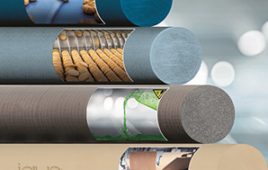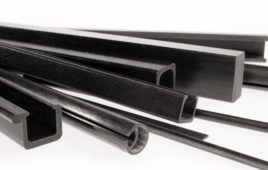Powerful, inexpensive and even flexible when they need to be, organic photodiodes are a promising alternative to silicon-based photodetectors. They are used to improve light sensitivity in cameras and to check displays for homogeneous color composition.
We have Mother Nature and her ingenious brand of technology to thank for our ability to see – our eyes capture light from our environment and our retinas transform it into an electronic signal that is passed on to the brain as information. Optical components – like photodetectors – work according to the same principle. They can be found in digital cameras and are also used in automation technology, bioanalytics and medical imaging diagnostics. Optical components are typically made from inorganic materials such as silicon. But scientists at the Fraunhofer Research Institution for Organics, Materials and Electronic Devices COMEDD in Dresden are now also developing organic photodiodes (OPD) that rely on organic materials such as dyes or pigments.
“These kinds of OPD offer a range of advantages compared with inorganic components – they’re extremely lightweight, cheap to produce and can be used for flexible applications,” explains COMEDD head of department Dr. Olaf R. Hild.
The choice of which material to use is determined primarily by the wavelength spectrum customers select for their applications. Organic materials are each sensitive only to a particular wavelength range – for instance, they may react only to green light. So by choosing the right material, scientists can control and tailor the spectral sensitivity of their optical sensors.
The available materials already cover a broad wavelength spectrum. For special applications, for instance in the UV or near-infrared range, the Dresden-based scientists are also developing compact micro-sensors that combine organic semiconductors with silicon technology.
Increased light sensitivity using photodiodes
Uses vary from tiny sensor elements for cameras or for bioanalytics to large-scale, quality control applications. In lab-on-chip applications, for instance, OPDs can detect certain DNA sequences that have been tagged with fluorescent markers. Hild explains how photodiodes help to increase a high-end camera’s light sensitivity.
“Integrating our organic photodiodes increases the light sensitivity of today’s CCD chips by providing a larger usable surface.” OPDs can also be used to check the homogeneity of the color composition or the brightness distribution of luminescent surfaces such as displays.
Unlike their silicon-based counterparts, OPDs also allow for flexible components. Here photodiodes are integrated into polymer films that can be applied to concave or curved surfaces. This could be used to develop quality control systems specially shaped to the product to be placed inside them so that whole car doors could be examined for scratches or any quality inconsistencies in the paintwork. And it is particularly in such large-scale applications that OPDs offer a cheaper alternative to traditional technologies: whereas it is very difficult and expensive to cover large surfaces with silicon, OPDs can be applied to comparatively inexpensive materials using simple coating techniques.
This means that the scientists can utilize established manufacturing techniques such as those used to manufacture organic photovoltaics, for example. At this year’s SERSOR + TEST the scientists will be presenting a color sensor featuring four organic photodiodes, each one with its own spectral sensitivity.
Filed Under: Materials • advanced




